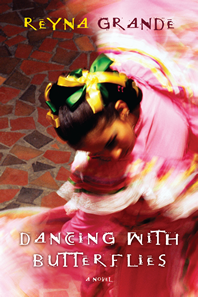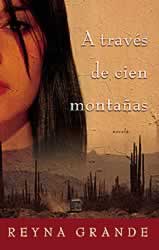

2010 Bookshop Santa Cruz Book Club pick (May)
2010 San Mateo County Library "One Book/One Community" (Spanish)
2010 City of Watsonville "On the Same Page " (community read)
2009 Schoolcraft College Campus Read & Pageturners Book Club selection
2009 Teen Author Series, Free Library of Philadelphia
2008 Required Reading--Summer Bridge Program at Taft College, CA
2007 Eastern Connecticut's "One Book/One Region"
2007 American Book Award
2007 SummerTIME Read (USC)
2006 El Premio Aztlan Literary Award
2006 UCSC Freshmen Read (Kresge & Porter)
2006 "Top Adventure Book by a Latina Author" Award, Catalina Magazine
Required Reading/Featured Book at:
UC, Santa Cruz
UC, Santa Barbara
Cal State University, Los Angeles
Cal State University, Dominguez Hills
Bakersfield College
Queens College
Santa Monica College
UC, Irvine
Butte College (LEAP)
USC (SummerTIME)
Taft College (Summer Bridge Program)
Schoolcraft College-"Official Campus Read" (Livonia, MI)
Mount San Antonio College (CA)
Girls Middle School, (Mountainview, CA)
School of Global Studies (L.A., CA)
Norwich Free Academy (CT)
Coast Guard Academy (CT)
Watsonville High School (Parent/Student book club "Padres Como Socios"),
Rio Hondo College
Santa Barbara City College
Compton High School (Compton, CA)
El Camino High School (South S.F., CA)
Renaissance High School (Watsonville, CA)
Pajaro Valley High School (Watsonville, CA)
Watsonville High School
Sacred Heart High School (Lincoln Heights, CA)
Hartnell College (Salinas, CA)
Los Angeles High School of the Arts (L.A., CA)
Click here for Lessons Plans for Across a Hundred Mountains.
ACROSS A HUNDRED MOUNTAINS
Across a Hundred Mountains is a stunning and poignant story of migration, loss, and discovery--as two women, one born in Mexico, one from the U.S., find their lives joined in the most unlikely way.
After a tragedy that separates her from her mother, Juana Garcia leaves her small town in Mexico to find her father who left his home and family two years before to find work in America, El Otro Lado, and rise above the oppressive poverty so many of his countrymen endure. Out of money and in need of someone to help her across the border, Juana meets Adelina Vasquez, a young woman who left her family in California to follow her lover to Mexico. Finding each other--in a Tijuana city jail--they offer each other much needed material and spiritual support and ultimately become linked in the most unexpected way. Using a non-linear narrative style, where the pieces don't fall into place until the very end, Grande takes readers inside the lives of the people of Mexico who are left behind in the phenomenon of migration to the United States.
Mexican immigration is one of the most talked about, controversial issues in the news today. Author Reyna Grande, who came to the United States when she was nine, has an insider's perspective that lends insight to this politically charged issue. Across a Hundred Mountains puts a human face on the epic story about those who make it across the border, those who never make it across, and those who are left behind.
Who are the men, women and children whose lives are affected by the forces that propel so many to risk life and limb, crossing the border in pursuit of a better life? Take the journey Across a Hundred Mountains and see.
PRAISE FOR ACROSS A HUNDRED MOUNTAINS
"Grande's spare, elegantly written tale of a young Mexican girl searching for her farmworker father, missing since he left to seek his fortune in 'el otro lado', is a timely and riveting read." --People Magazine
“Grande's deft portraiture endows even the smallest characters with grace.” — Publisher's Weekly, starred review
"An affecting debut on Mexican poverty, illegal immigration and cosmic injustice. " --Kirkus Reviews
"A breathtaking debut." --El Paso Times
"Grande's heartfelt [novel] addresses a worthy subject — the desperation of illegal immigrants and the families they leave behind. " --Entertainment Weekly
Reading Guide
SUMMARY
After years of taking care of her mother, Juana Garcia leaves her small town in Mexico to find her father who disappeared nineteen years earlier. Out of money and in need of someone to help her cross the border, Juana meets Adelina Vasquez, who left her family in California three years prior to follow forbidden love in Mexico.
After the two women join forces in the most unlikely locale -- a Tijuana city jail -- nothing is ever quite what it seems. In a vivid novel depicting dreams deferred and dreams fulfilled, Grande takes readers inside the lives of Mexicans who are left behind in the phenomenon of migration to the United States.
READING GROUP DISCUSSION
1. Early in the book, we learn that Juana is enslaved to feelings of guilt and obligation: "Her father's ashes. Her redemption. Perhaps after she delivered the ashes to her dying mother there would be no more demons to haunt her, and she would be able to lower her head on a pillow and sleep" (page 12). What event initially inspires Juana's remorse? How does that event shape the character she ultimately becomes? Besides the search for her father, in what other ways does Juana attempt to redeem herself?
2. As the story flips between plotlines, the conclusion of one chapter is often very similar to the introduction of the next, at least in terms of what each character is doing. Find as many examples as you can throughout the book where the transition between Adelina and Juana involves the two characters taking part in the same activity. What effect does this technique have on the story as a whole?
3. The author uses vivid imagery throughout the novel to bring the experiences of Juana and Adelina to the reader. What imagery was the most striking? What other techniques does the author employ to involve the reader in the setting and events?
4. When Adelina sleeps in the park after first arriving in Los Angeles, the man who directs her towards Don Ernesto offers an interesting theory about the moon: "'It has two faces. She only shows one face to the world. Even though it changes shape constantly, it's always the same face we see. But her second face, her second face remains hidden in darkness. That's the face no one can see. People call it the dark side of the moon. Two identities. Two sides of a coin...'" (page 25). Does Adelina identify with the moon? What ultimate revelation does this statement serve to foreshadow?
5. At what point in the novel do you begin to consider the possibility that the two characters, Adelina and Juana, are in fact the same person? What does the author accomplish in constructing the novel in this way? Does the narrative style of each identity differ in any way?
6. Lupe, Juana's mother, believes the saints punish her for succumbing to Don Elias and sleeping with him in order to pay off her debt. Even when she takes part in the Semana Santa ceremony as a flagelante, she receives no salvation and never gets her son back. Lupe's life plummets after this final failed attempt for redemption, but is her faith itself altered?
7. In spite of all the suffering Juana watches her mother go through, she eventually repeats her mother's actions -- surrendering perhaps even more than Lupe did -- when she becomes a prostitute. Is Juana's desire to find her father worthy of such a sacrifice?
8. Prayers made to saints often go unanswered in the novel. "Juana remembered the times of long ago when the saints and La Virgen de Guadalupe had been there for them. But now, all the statues were covered with dust, and the flower petals had long ago shriveled" (page 130). Does Juana's (Adelina's) faith change throughout the course of the novel? What does she rely upon to keep her hope alive?
9. Don Ernesto becomes somewhat of a father figure to Adelina, yet she breaks her final promise to him when she denies herself the "chance to be happy with" Sebastian (page 158). What motivates her to make this choice? Although the reader never learns if Adelina returns to Sebastian, do you think the author implies in the conclusion that Adelina is in fact ready to follow through on her promise to Don Ernesto?
10. Duality is a predominant theme in this book. Besides Juana, are there any other characters that develop different identities? What characters resemble one another, especially in terms of what they mean to Juana/Adelina?
11. The story opens and closes with "Adelina" chapters. Do you think this was a conscious decision the author made? If so, what is the significance of this choice?
12. The main characters in Across a Hundred Mountains are women, several of whom are victims of male brutality or abandonment. What effect do these characterizations have upon the overall message of the novel?
ENHANCE YOUR BOOKCLUB
1. Set the mood with food! However sparse her meal, what Juana eats is often described in great detail throughout Across a Hundred Mountains. Before your book club meeting, look online for recipes (this site has many Mexican meal suggestions: http://www.mexgrocer.com/) for the authentic Mexican dishes and foods that the characters eat, such as quesadillas. Assign different dishes to members in your book club and bring the food to your meeting.
2. Juana ultimately assumes Adelina's identity. Before your book group meets to discuss Across a Hundred Mountains, have fun playing with this theme. Draw names to swap "identities" with another member in your club, and come dressed up as that member for your meeting. Everyone in the group can take turns guessing who each person has become!
Teachers and Book Clubs:
If you are using Across a Hundred Mountains or reading it with your group, send me an email about doing an author presentation!

click here to go to Dancing with Butterflies

Click Here to go to A Traves de Cien Montanas